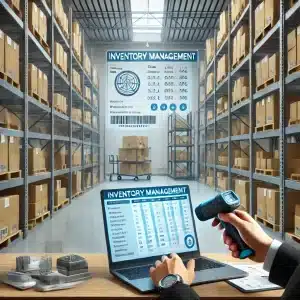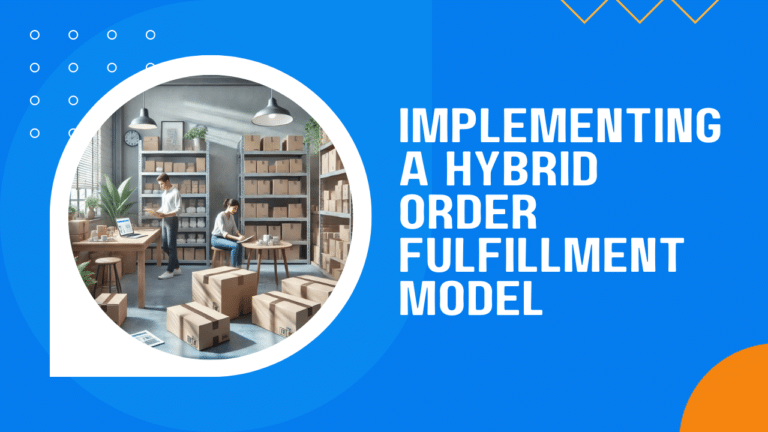Meeting customer expectations for quick, accurate, and cost-effective deliveries is paramount for the success of an ecommerce business. As businesses scale and diversify their product offerings, relying on a single fulfillment strategy often falls short. Enter the hybrid order fulfillment model—an innovative approach that blends multiple fulfillment methods to optimize efficiency and flexibility.
Implementing a hybrid order fulfillment model is not a one-size-fits-all solution. It involves a series of well-structured steps to seamlessly integrate in-house fulfillment, third-party logistics (3PL), dropshipping, and store fulfillment into a cohesive system. This article outlines the key steps necessary for a successful implementation, ensuring businesses can adapt to varying demand, manage costs effectively, and ultimately enhance customer satisfaction. From conducting a thorough assessment of current operations to developing a robust strategy and leveraging technology, each step is crucial in building a resilient hybrid fulfillment model.
Steps to Implement a Hybrid Order Fulfillment Model
Implementing a hybrid order fulfillment model involves a structured approach to integrate multiple fulfillment methods effectively. Here are the key steps to ensure a successful implementation:
Assessment
This order fulfillment model begins with a comprehensive assessment of your current fulfillment processes, costs, and customer needs. This foundational step is crucial for identifying the strengths and weaknesses of your existing system and determining the best strategies for integrating multiple fulfillment methods. Here’s a detailed breakdown of the key elements involved in the assessment phase:
Analyze Current Fulfillment Processes
- Evaluate Efficiency: Examine your current warehousing, picking and packing, and shipping processes to identify bottlenecks, inefficiencies, and areas for improvement.
- Performance Metrics: Review key performance indicators (KPIs) such as order accuracy, fulfillment speed, return rates, and customer satisfaction scores to gauge the effectiveness of your current system.
- Process Mapping: Create detailed maps of your fulfillment workflows to visualize each step and identify where different methods can be integrated or optimized.
Assess Costs
- Cost Breakdown: Analyze the costs associated with each aspect of your fulfillment process, including labor, warehousing, packaging, and shipping.
- Comparison with Alternatives: Compare these costs with the potential expenses of third-party logistics (3PL), dropshipping, and store fulfillment options to understand where savings can be made.
- ROI Analysis: Evaluate the return on investment (ROI) for current fulfillment operations and potential hybrid models, considering both direct and indirect costs.
Understand Customer Needs
- Customer Expectations: Gather data on customer expectations regarding delivery times, shipping costs, and order accuracy. Surveys, feedback forms, and customer service interactions can provide valuable insights.
- Order Patterns: Analyze order patterns to identify trends in product demand, peak order times, and geographic distribution of your customer base.
- Service Level Requirements: Determine the required service levels for different customer segments, such as express shipping for premium customers or standard shipping for regular buyers.

Inventory Management
- Current Inventory Levels: Assess your current inventory levels and turnover rates to understand stock availability and storage needs.
- Inventory Distribution: Analyze how your inventory is distributed across different locations and how this impacts delivery times and shipping costs.
- Stock Management: Identify issues in stock management, such as overstocking, stock outs, or mismanaged inventory, that could affect fulfillment efficiency.
Technology and Infrastructure
- Existing Technology: Review the technology currently in use, including order management systems (OMS), warehouse management systems (WMS), and ecommerce platforms.
- Integration Capabilities: Assess the capability of your existing technology to integrate with new fulfillment methods, such as 3PL and dropshipping platforms.
- Infrastructure Readiness: Evaluate your physical infrastructure, including warehousing capacity and distribution centers, to determine readiness for a hybrid model.
SWOT Analysis
- Strengths: Identify strengths in your current fulfillment process that can be leveraged, such as efficient in-house operations or strong relationships with logistics partners.
- Weaknesses: Highlight weaknesses that need addressing, such as slow fulfillment times or high shipping costs.
- Opportunities: Recognize opportunities for improvement and growth, like expanding to new markets or integrating advanced technology.
- Threats: Consider potential threats, including competitive pressures, supply chain disruptions, or changes in customer expectations.
Competitive Benchmarking
- Industry Standards: Compare your fulfillment operations against industry standards and best practices to identify gaps and areas for improvement.
- Competitor Analysis: Analyze how competitors are managing their fulfillment processes, particularly those using hybrid models, to gain insights and ideas for your own strategy.
A thorough assessment gives businesses a clear understanding of their current fulfillment landscape and identifies the most effective ways to implement a hybrid order fulfillment model. This step sets the stage for developing a strategy that optimizes operations, reduces costs, and enhances customer satisfaction.
Strategy Development
After completing a thorough assessment of your current fulfillment processes, the next step is to develop a comprehensive strategy for implementing a hybrid order fulfillment model. This strategy should outline the optimal mix of fulfillment methods, set clear objectives, and establish key performance indicators (KPIs) to guide and measure success. Here are the detailed steps for effective strategy development:
Define Clear Objectives
- Operational Efficiency: Set goals for improving the speed, accuracy, and cost-effectiveness of your fulfillment processes.
- Customer Satisfaction: Aim to enhance customer experience by providing faster delivery times, more shipping options, and reliable service.
- Scalability: Ensure the strategy can accommodate business growth and handle fluctuations in demand.
- Risk Mitigation: Develop plans to reduce reliance on any single fulfillment method and ensure business continuity during disruptions.
Determine Optimal Fulfillment Mix
- In-House Fulfillment: Decide which products or order types are best suited for in-house processing. This might include high-margin items, custom products, or orders requiring special handling.
- Third-Party Logistics (3PL): Identify the role of 3PL providers in your strategy. Consider using them for handling large volumes, international shipments, or peak season surges.
- Dropshipping: Determine the products that can be effectively dropshipped. Typically, this includes low-margin items, high-variability products, or new products you want to test without holding inventory.
- Store Fulfillment: Plan for leveraging brick-and-mortar stores for local fulfillment, offering options like Buy Online, Pick Up In-Store (BOPIS), or ship-from-store to reduce delivery times and costs.
Set Key Performance Indicators (KPIs)
- Order Accuracy: Measure the percentage of orders fulfilled correctly without errors.
- Fulfillment Speed: Track the time taken from order placement to shipment and delivery.
- Customer Satisfaction: Use metrics like Net Promoter Score (NPS), customer reviews, and return rates to gauge satisfaction.
- Cost Efficiency: Monitor costs associated with each fulfillment method and overall fulfillment costs as a percentage of sales.
- Scalability Metrics: Assess the ability to handle increased order volumes without compromising service quality.
Develop Detailed Plans for Each Fulfillment Method
- In-House Fulfillment: Outline processes for inventory management, order picking and packing, and quality control. Determine staffing needs and training requirements.
- Third-Party Logistics (3PL): Select reliable 3PL partners, establish contracts and service level agreements (SLAs), and integrate their systems with your OMS and WMS.
- Dropshipping: Choose dropshipping suppliers, integrate their catalogs with your ecommerce platform, and set up automated order routing and tracking.
- Store Fulfillment: Equip stores with the necessary technology and training for order picking and packing. Implement inventory tracking systems to manage stock levels across all locations.
Technology Integration
- Order Management System (OMS): Implement or upgrade your OMS to coordinate orders across all fulfillment methods. Ensure it can route orders efficiently based on factors like inventory availability, customer location, and delivery speed.
- Warehouse Management System (WMS): Integrate your WMS with the OMS and ensure it supports real-time inventory tracking, automated replenishment, and efficient picking and packing processes.
- Ecommerce Platform: Ensure your ecommerce platform supports multi-channel fulfillment and provides a seamless customer experience with real-time order tracking and multiple shipping options.
Collaboration and Communication
- Internal Teams: Foster collaboration between different departments, such as logistics, customer service, and sales, to ensure alignment and smooth implementation of the hybrid model.
- External Partners: Maintain open communication channels with 3PL providers, dropshipping suppliers, and store managers to ensure all parties are aligned with the strategy and can address any issues promptly.
Pilot Testing
- Small-Scale Implementation: Start with a pilot program to test the hybrid model on a small scale. Choose specific product lines or geographic areas for the initial rollout.
- Monitor and Adjust: Collect data during the pilot phase, analyze performance against KPIs, and make necessary adjustments to processes, technology, and partnerships.
Continuous Improvement
- Regular Reviews: Conduct regular reviews of fulfillment performance, customer feedback, and market trends to identify areas for improvement.
- Adapt and Scale: Use insights from reviews to refine your strategy and scale the hybrid model across your entire operation. Stay agile and ready to adapt to changing market conditions and customer expectations.
Technology Integration
Technology integration is a critical component of implementing a hybrid order fulfillment model. It ensures that all parts of the fulfillment process are synchronized, enabling efficient and accurate order processing. The key technologies involved include Order Management Systems (OMS), Warehouse Management Systems (WMS), and ecommerce platforms. Here is a detailed look at each technology and how they integrate to support a hybrid order fulfillment model:
Order Management System (OMS)
An Order Management System (OMS) is the backbone of a hybrid order fulfillment model. It coordinates orders across multiple fulfillment channels and ensures that each order is routed to the most appropriate fulfillment method based on predefined criteria such as inventory levels, customer location, and delivery speed.
- Order Routing: The OMS automates the decision-making process for order fulfillment, selecting the best method (in-house, 3PL, dropshipping, or store fulfillment) to optimize efficiency and cost.
- Inventory Synchronization: Integrates with WMS and ecommerce platforms to provide real-time inventory visibility across all fulfillment channels, preventing stockouts and overselling.
- Multi-Channel Support: Handles orders from various sales channels (online store, marketplaces, physical stores) and ensures a unified order processing workflow.
- Customer Communication: Automates customer notifications for order confirmations, shipping updates, and delivery tracking, enhancing the customer experience.
Warehouse Management System (WMS)

A Warehouse Management System (WMS) manages the day-to-day operations within warehouses and distribution centers. It ensures efficient inventory management, order picking, packing, and shipping processes.
- Inventory Tracking: Provides real-time tracking of inventory levels, locations, and movements within the warehouse, ensuring accurate stock counts and minimizing discrepancies.
- Order Picking and Packing: Optimizes picking routes and packing processes to reduce processing times and improve accuracy. Supports various picking methods (e.g., batch picking, wave picking) to match order volumes and warehouse layouts.
- Integration with OMS: Syncs with the OMS to receive and process orders efficiently, ensuring that inventory data is updated in real-time across all systems.
- Performance Analytics: Tracks key performance metrics (e.g., picking accuracy, order processing times, labor productivity) to identify areas for improvement and optimize warehouse operations.
Ecommerce Platform
The ecommerce platform is where customers interact with the business, place orders, and track their shipments. Integration with OMS and WMS is essential to provide a seamless shopping experience and efficient fulfillment.
- Real-Time Inventory Updates: Displays accurate inventory levels on product pages, preventing customers from ordering out-of-stock items.
- Order Processing: Transmits order information to the OMS for routing and fulfillment. Supports various payment methods and ensures secure transactions.
- Customer Experience: Provides features such as estimated delivery dates, multiple shipping options, and order tracking to enhance customer satisfaction.
- Omnichannel Capabilities: Supports omnichannel initiatives like Buy Online, Pick Up In-Store (BOPIS) and ship-from-store, leveraging physical store inventory for online orders.
Integration Best Practices
- API Integration: Use APIs to connect OMS, WMS, and ecommerce platforms, enabling seamless data exchange and real-time updates. Ensure that all systems communicate effectively to avoid data silos and discrepancies.
- Data Standardization: Standardize data formats and protocols across all systems to ensure compatibility and ease of integration. This includes product information, inventory data, and order details.
- Scalability: Choose scalable technology solutions that can grow with your business. Ensure that the systems can handle increasing order volumes, additional sales channels, and expanding product lines.
- Security: Implement robust security measures to protect sensitive data, including customer information, payment details, and inventory data. Ensure that all systems comply with relevant data protection regulations.
- Testing and Validation: Conduct thorough testing during the integration phase to identify and resolve any issues. Validate that all systems are functioning correctly and that data is accurately synchronized across platforms.
- Continuous Monitoring and Maintenance: Regularly monitor the integrated systems to ensure they operate smoothly. Perform routine maintenance, updates, and optimizations to keep the technology infrastructure robust and efficient.
Businesses can create a cohesive and efficient hybrid order fulfillment system by integrating these technologies effectively, resulting in enhanced operational efficiency, reduced costs, and improved customer satisfaction.
Partnerships
Forming strategic partnerships is a vital aspect of implementing a hybrid order fulfillment model. These partnerships include third-party logistics (3PL) providers, dropshipping suppliers, and technology vendors. Effective collaboration with these partners ensures that your fulfillment operations are efficient, scalable, and capable of meeting customer expectations. Here’s a detailed look at how to develop and manage these essential partnerships:
Third-Party Logistics (3PL) Providers
Selecting the Right 3PL Partner

- Experience and Expertise: Choose 3PL providers with a proven track record in your industry. They should have expertise in handling your specific product types and fulfillment needs.
- Geographic Reach: Ensure the 3PL has a network of warehouses and distribution centers that align with your target markets to reduce shipping times and costs.
- Technology Integration: The 3PL should have robust technology systems that can seamlessly integrate with your OMS and WMS for real-time data exchange and visibility.
- Scalability: Look for partners that can scale their operations to accommodate your business growth and seasonal fluctuations in order volume.
Establishing Service Level Agreements (SLAs)
- Performance Metrics: Define clear performance metrics such as order accuracy, fulfillment speed, and on-time delivery rates. These metrics will be used to measure the 3PL’s performance.
- Responsibilities and Expectations: Clearly outline the responsibilities of both parties, including inventory management, order processing, and customer service.
- Penalties and Incentives: Include penalties for not meeting SLAs and incentives for exceeding them to ensure high performance and accountability.
Communication and Collaboration
- Regular Meetings: Schedule regular meetings with your 3PL partner to discuss performance, address issues, and plan for future needs.
- Real-Time Communication: Use technology to enable real-time communication and data sharing. This ensures that both parties are always informed and can quickly respond to any issues.
Get a quote and partner with ShipBuddies as your third-party logistics provider.
Dropshipping Suppliers
Choosing Reliable Suppliers
- Product Quality: Select suppliers known for their high product quality and reliability. This ensures that customers receive products that meet their expectations.
- Inventory Management: Ensure suppliers have adequate inventory levels and efficient inventory management systems to prevent stockouts and delays.
- Shipping Capabilities: Verify that suppliers can ship products promptly and have reliable logistics networks to ensure timely deliveries.
Integrating with Suppliers
- System Integration: Integrate your ecommerce platform with suppliers’ systems to automate order processing and inventory updates. This reduces manual work and minimizes errors.
- Real-Time Inventory Updates: Ensure that your system receives real-time inventory updates from suppliers to prevent overselling and stock discrepancies.
- Order Tracking: Implement systems that allow you and your customers to track orders in real-time, providing transparency and enhancing the customer experience.
Building Strong Relationships
- Open Communication: Maintain open lines of communication with suppliers to address any issues quickly and efficiently. Regular updates and check-ins can help strengthen the partnership.
- Mutual Goals: Align your business goals with your suppliers’ goals to ensure a mutually beneficial relationship. This can include shared targets for sales growth, customer satisfaction, and operational efficiency.
Technology Vendors
Selecting Technology Partners
- Reputation and Reliability: Choose technology vendors with a strong reputation for reliability and excellent customer service. Look for reviews and case studies from similar businesses.
- Compatibility and Integration: Ensure that the technology solutions provided by vendors are compatible with your existing systems and can be integrated seamlessly.
- Scalability: Opt for technology solutions that can scale with your business, accommodating increased order volumes and additional sales channels.
Defining Technical Requirements
- System Specifications: Clearly define the technical requirements and specifications needed for integration with your OMS, WMS, and ecommerce platform.
- Support and Training: Ensure that technology vendors provide comprehensive support and training for your team to maximize the use of their solutions.
Collaborating for Continuous Improvement
- Feedback and Updates: Provide regular feedback to your technology vendors to help them improve their solutions. Stay updated on new features and updates that can enhance your fulfillment operations.
- Innovation Partnership: Work with technology vendors as partners in innovation, exploring new technologies and solutions that can further optimize your hybrid fulfillment model.
Best Practices for Managing Partnerships
Regular Performance Reviews
- Track Performance Metrics: Continuously monitor the performance of your partners against the defined SLAs and KPIs.
- Review Meetings: Hold regular review meetings to discuss performance, address any issues, and plan for future improvements.
Foster Strong Relationships
- Transparency and Trust: Build transparent and trust-based relationships with your partners. This includes sharing relevant data and insights that can help improve performance.
- Mutual Benefits: Ensure that partnerships are mutually beneficial by aligning goals and incentives. This encourages partners to invest in the success of your fulfillment operations.
Flexibility and Adaptability
- Adapt to Changes: Be prepared to adapt your partnership agreements as your business needs evolve. This might include renegotiating terms, expanding the scope of services, or incorporating new technologies.
- Continuous Improvement: Encourage a culture of continuous improvement within your partnerships. Regularly seek feedback and identify areas where processes can be optimized.
By strategically developing and managing partnerships with 3PL providers, dropshipping suppliers, and technology vendors, businesses can create a robust hybrid order fulfillment model. These partnerships are essential for ensuring that fulfillment operations are efficient, scalable, and capable of meeting the ever-changing demands of the market and customers.
Continuous Improvement
Continuous improvement is a critical aspect of maintaining and enhancing a hybrid order fulfillment model. It involves regularly evaluating performance, seeking feedback, and making incremental improvements to processes, technology, and partnerships. By fostering a culture of continuous improvement, businesses can stay competitive, adapt to changing market conditions, and consistently meet customer expectations. Here are the key elements of continuous improvement in hybrid order fulfillment:
Regular Performance Monitoring
Key Performance Indicators (KPIs)
- Order Accuracy: Measure the percentage of orders fulfilled correctly without errors.
- Fulfillment Speed: Track the time taken from order placement to shipment and delivery.
- Customer Satisfaction: Use metrics such as customer reviews and return rates to gauge satisfaction.
- Cost Efficiency: Monitor fulfillment costs as a percentage of sales and compare them against industry benchmarks.
- Inventory Turnover: Assess how quickly inventory is sold and replaced, indicating efficient inventory management.
Data Analytics
- Real-Time Tracking: Implement real-time tracking of KPIs to quickly identify issues and trends.
- Historical Analysis: Analyze historical data to understand performance patterns and identify areas for improvement.
- Predictive Analytics: Use predictive analytics to forecast demand, optimize inventory levels, and plan for peak periods.
Gathering and Implementing Feedback
Customer Feedback
- Surveys and Reviews: Collect feedback through customer surveys, reviews, and direct interactions. Analyze this feedback to identify common issues and areas for improvement.
- Focus Groups: Conduct focus groups to gain deeper insights into customer preferences and pain points.
- Customer Service Interactions: Monitor customer service interactions to identify recurring problems and address them proactively.
Partner Feedback
- Regular Meetings: Hold regular meetings with 3PL providers, dropshipping suppliers, and technology vendors to discuss performance and gather feedback.
- Performance Reviews: Conduct performance reviews based on SLAs and KPIs to ensure partners meet expectations and identify areas for improvement.
- Collaborative Workshops: Organize workshops with partners to brainstorm solutions and share best practices.
Internal Feedback
- Team Meetings: Hold regular team meetings to discuss operational challenges and gather suggestions for improvement from employees.
- Employee Surveys: Conduct surveys to collect feedback from warehouse staff, customer service representatives, and other employees involved in the fulfillment process.
- Cross-Functional Teams: Form cross-functional teams to address specific challenges and develop solutions collaboratively.
Process Optimization
Lean Principles
- Value Stream Mapping: Map out the entire fulfillment process to identify value-added and non-value-added activities. Streamline processes to eliminate waste and improve efficiency.
- Continuous Flow: Implement continuous flow principles to minimize bottlenecks and ensure a steady movement of orders through the fulfillment process.
- Kaizen: Adopt the Kaizen philosophy of continuous improvement by encouraging small, incremental changes that collectively lead to significant improvements.
Automation and Technology Upgrades
- Automated Systems: Invest in automated systems for inventory management, order picking, packing, and shipping to reduce manual errors and increase efficiency.
- AI and Machine Learning: Use AI and machine learning to optimize order routing, demand forecasting, and inventory management.
- Technology Updates: Regularly update your OMS, WMS, and ecommerce platforms to leverage the latest features and improvements.
Training and Development
- Employee Training: Provide ongoing training to employees to ensure they are skilled in using new technologies and following best practices.
- Skills Development: Encourage skills development through workshops, courses, and certifications to keep employees updated with the latest industry trends and technologies.
- Knowledge Sharing: Foster a culture of knowledge sharing where employees can learn from each other’s experiences and best practices.
Innovation and Adaptation
Stay Informed
- Industry Trends: Stay informed about industry trends, emerging technologies, and best practices in order fulfillment.
- Competitive Analysis: Monitor competitors to understand their fulfillment strategies and identify areas where you can differentiate and improve.
Experimentation
- Pilot Programs: Implement pilot programs to test new technologies, processes, or fulfillment methods on a small scale before full deployment.
- A/B Testing: Use A/B testing to compare the effectiveness of different fulfillment strategies or technologies and identify the best options.
Flexibility and Agility
- Adapt to Change: Be prepared to adapt to changes in market conditions, customer expectations, and technological advancements. This includes being agile in response to supply chain disruptions, seasonal demand fluctuations, and new market opportunities.
- Scalability: Ensure that your fulfillment model is scalable to accommodate business growth and increased order volumes without compromising efficiency or customer satisfaction.
By focusing on continuous improvement, businesses can ensure that their hybrid order fulfillment model remains efficient, responsive, and capable of meeting the evolving needs of customers. This approach not only enhances operational performance but also fosters a culture of excellence and innovation within the organization.
Conclusion
Implementing a hybrid order fulfillment model is a strategic move that can significantly enhance the efficiency and flexibility of your logistics operations. By following a structured approach, businesses can seamlessly integrate multiple fulfillment methods—such as in-house fulfillment, third-party logistics (3PL), dropshipping, and store fulfillment—into a cohesive system.
This model starts with a thorough assessment of current processes, identifying strengths and weaknesses, and understanding customer needs. From there, developing a robust strategy that includes clear objectives, optimal fulfillment mixes, and key performance indicators ensures that each method is used effectively. Technology integration plays a critical role in synchronizing all parts of the fulfillment process, while strong partnerships with 3PL providers, suppliers, and technology vendors are essential for scalability and efficiency.
Continuous improvement is vital for maintaining and enhancing the hybrid model. Regular performance monitoring, gathering and implementing feedback, and process optimization help businesses stay competitive and adapt to changing market conditions. By embracing these steps, companies can build a resilient hybrid order fulfillment system that meets the evolving needs of their customers, supports sustainable growth, and ensures operational excellence.









